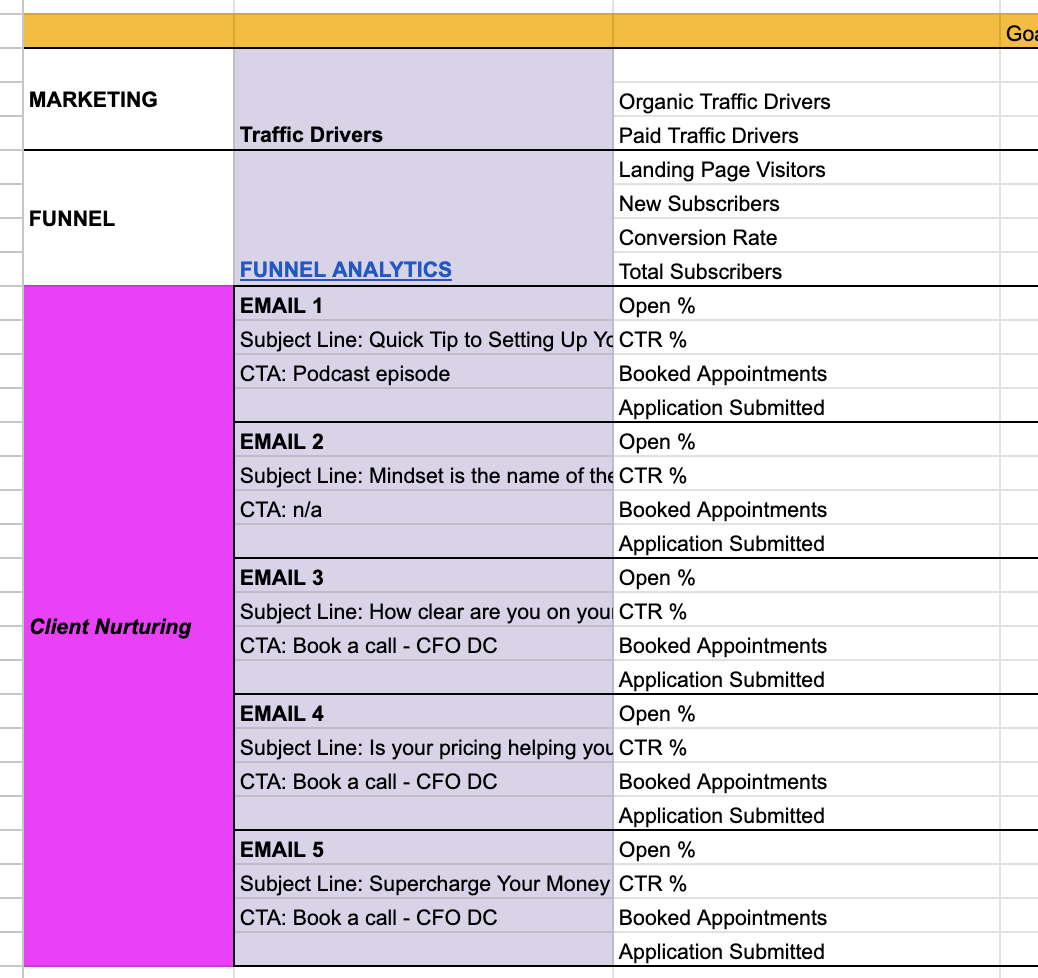Start tracking these Marketing Metrics in Your Business
Start tracking these Marketing Metrics in Your Business
Just like our finances, when you start to track your marketing metrics, you’ll be able to start seeing better ROI on your marketing efforts.
So if you’re ready to start seeing a better ROI on your marketing dollars and time, then let’s dive into this blog post.
I’m a bit of a spreadsheet enthusiast—yes, I’ve got a serious love affair with trackers—but I promise, it’s not as boring as it sounds.
In fact, tracking the right marketing metrics can be a game-changer, helping you spot opportunities for immediate improvement and get excited about the results you’re seeing.
Whether you're tweaking your funnels, analyzing your email marketing, diving into social media stats, or evaluating ad performance, understanding these key metrics is like having a secret recipe for success.
So grab your favorite coffee, open those spreadsheets, and let’s uncover the insights that will drive your conversions through the roof!
Funnel Tracking if You're Using Sales Funnels
Funnels are like your business’s guided tour, leading potential customers step-by-step to the ultimate goal—conversion! Here’s how to make sure your funnel is a VIP experience:
Page Visits: Keep an eye on how many visitors are landing on each page of your funnel. If traffic is high but conversions are low, it might be time for a funnel makeover!
Email Open Rates: Track the open rates for each email in your sequence. A high open rate means your subject lines are on point. If not, it might be time to spice them up with some irresistible hooks.
Click-Through Rates (CTR): Analyze how many people are clicking on your CTAs. Low CTR? It could be a sign that your content or CTAs need to pack more punch.
Booked Appointments: For businesses that thrive on setting appointments, track how many are actually being booked through your funnel. If this number isn’t where you want it, you might need to tweak your approach.

Problems If Not Tracked:
Missed Opportunities: Without tracking page visits and CTR, you might not realize where your funnel is losing potential customers, leading to missed opportunities and suboptimal conversion rates.
Ineffective Emails: Failing to track open rates and CTR can result in poorly performing email campaigns that don’t engage your audience or drive desired actions.
Underperforming CTAs: Not monitoring CTA performance can lead to ineffective calls to action, which means fewer clicks and lower conversion rates.
Email Open Rates and CTRs if You're Using Email Marketing:
Email marketing is like your business’s personal conversation with potential customers. From sending out newsletters to targeted campaigns, it's important that you're focused on the metrics.
Open Rates: Measure how many recipients are opening your emails. A high open rate shows your subject lines are hitting the mark. Low rates? Time to experiment with different lines to grab attention.
Click-Through Rates (CTR): Evaluate how many recipients are clicking on your links. This metric reveals how effective your content and CTAs are. If CTR is low, consider revamping your email content to make it more engaging.
Conversion Rates: Track how many email recipients take the desired action, like making a purchase or signing up for a webinar. This is the ultimate measure of your email’s success in driving conversions.
Problems If Not Tracked:
Low Engagement: Ignoring open rates and CTR can lead to a lack of engagement, meaning your emails aren’t capturing your audience’s interest or driving them to take action.
Wasted Resources: Without tracking conversion rates, you might be investing time and money into email campaigns that aren’t delivering the desired results.
Social Media Engagement Tracker if you're Spending Time on SM
Social media is your stage, and it’s time to shine! Here’s how to measure your performance and keep your audience engaged:
Engagement on Posts: Track likes, comments, shares, and other interactions. High engagement means your content is resonating with your audience. Focus on this rather than just the follower count—it’s the engagement that really matters.
Reach to Non-Followers: Monitor how many people outside your current follower base are seeing your posts. Expanding your reach can help you connect with new potential customers.
New Followers Gained: While follower count isn’t everything, tracking new followers can help you gauge how well your content and campaigns are attracting and retaining an audience.
Problems If Not Tracked:
Engagement Blind Spots: Not tracking engagement and reach can lead to missed insights about what content resonates with your audience and what doesn’t.
Stagnant Growth: Without tracking new followers and reach, you might not realize if your social media strategy needs a refresh to attract and retain a growing audience.
Facebook Ads Tracker if You're Running Ads:
Ads are where your marketing budget meets your audience, so it’s crucial to track their performance. Here’s what to focus on:
Copy Performance: Analyze how different ad copies perform. Test various headlines, body texts, and CTAs to find what resonates best.
Headlines: Evaluate how well your ad headlines capture attention and drive clicks. A/B testing different headlines can help you identify the most effective options.
CTAs: Track how well your CTAs drive user actions. Effective CTAs should be clear, compelling, and aligned with your ad’s objective.
Cost Per Click (CPC): Monitor how much you’re paying for each click. Lower CPC means more efficient ad spending and better targeting.
Conversion Rates: Measure the percentage of ad clicks that result in a desired action, such as a purchase or sign-up. Higher conversion rates indicate your ads are doing their job.
Return on Ad Spend (ROAS): Calculate the revenue generated for every dollar spent on ads. A positive ROAS indicates that your ad campaigns are profitable and driving valuable conversions.
Problems If Not Tracked:
Inefficient Ad Spending: Without tracking CPC and ROAS, you could be wasting your budget on ads that aren’t delivering results or providing a poor return on investment.
Unoptimized Ads: Failing to analyze copy, headlines, and CTAs can result in poorly performing ads that don’t engage your audience or drive conversions effectively.
Getting the best ROI:
Tracking and analyzing these marketing metrics isn’t just about collecting data—it’s about turning insights into action and boosting your conversions.
By focusing on the right metrics, you can fine-tune your strategies, optimize your campaigns, and achieve outstanding results. Embrace the power of metrics, and let your spreadsheets and trackers be your guide to marketing success.
Here’s to making your next campaign your best one yet! And like always, if you need some support in all of this, book a financial clarity call with us today!


